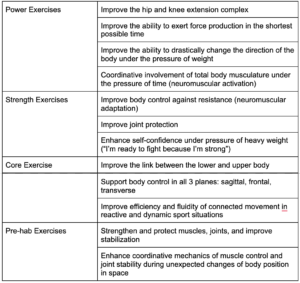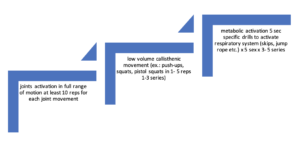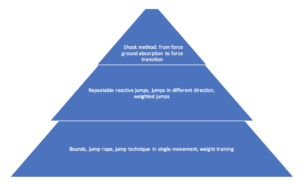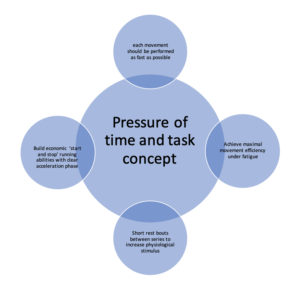Nov 9, 2021Building Effective Soccer Strength & Conditioning Programs
Modern soccer is characterized by intense, large volume microcycles, which require very precise and non-intrusive methods to guide the soccer-specific development of the athletes. The following article contains exercises that are meant to provide aid in training your athletes without interfering or taking up too much time of the specific and general strength and conditioning programs.
Strength
Soccer became a very fast game with repeated sprint ability in 90 minutes duration. Each match requires a wide variety of movements like jumps, runs, and throws. This high demand for discipline made the preparation period very important in injury prevention and improving motor ability. Sometimes small tips take your program to a higher level. Look wider, not only by the number of weights lifted but also by the ability to control the posture in dynamic tasks where muscle tension should control the body in transverse planes. That’s why the main purpose of soccer off-season is to increase the athlete’s resiliency to potential injury and develop the foundations of efficient movement. Strength training should be based on muscle activation analysis which is mostly involved in sprint running mechanisms and soccer drills.
Key to Exercise Selection in a Strength Program

Speed
Acceleration and rapid change of direction (COD) are key characteristics of soccer performance. The basic concept of pre-season soccer speed preparation is to develop high activation of the muscular system in order to quickly react to the ball or opponent movements. Sprinting is a highly developed neuromuscular mechanism that is clearly visible during human movement in space. To achieve heightened performance, training sessions should transition workouts into skill-based sessions. Speed training can be further stratified into linear and angular speed. The goal of linear speed training is to enhance ground force application especially during the first few steps of acceleration. The key of angular speed running sessions is to teach the athlete’s body proper control during COD. It’s very important to control the hip, knee, and ankle positions to ensure ligaments and body positions remain safe and efficient during angled COD.
 Speed sessions’ progression in linear and angular speed development should begin with introductory exercises such as skipping drills. This is to support a high quality of movement which will result in improved sprint performance. The rationale of skipping drills placement prior to sprint work is to allow for the development of proper mechanics of movement, primarily, pelvis control, proper foot-ground contact, and upper body stabilization.
Speed sessions’ progression in linear and angular speed development should begin with introductory exercises such as skipping drills. This is to support a high quality of movement which will result in improved sprint performance. The rationale of skipping drills placement prior to sprint work is to allow for the development of proper mechanics of movement, primarily, pelvis control, proper foot-ground contact, and upper body stabilization.
Speed training should focus on three main aspects: resisted sprinting, pure sprinting, and sprinting in reaction to the ball or opponent movements according to soccer-specific requirements. All three elements are mixed in each speed session and used as a stimulus for athletes’ muscle nervous system. It helps to hold players in a “standby” state and protects them against weariness.
Explosiveness
 The simplest method to raise power development is a plyometric training application. However, simple doesn’t mean easy. The essence of plyometric is to copy explosiveness to sports performance.
The simplest method to raise power development is a plyometric training application. However, simple doesn’t mean easy. The essence of plyometric is to copy explosiveness to sports performance.
The problem of plyometric training with soccer mostly is athletes’ weak muscles and poor technique. That’s why the proper application is required.
Endurance
The head coach prescribes large training volumes during the preparation period through small, medium, and large-sided games. This enables positive adaptations in soccer-specific endurance. This begs the question of how to properly incorporate extra endurance sessions during the offseason in order to maintain stamina development and allow time for adequate recovery between conditioning and soccer-specific endurance work. The most appropriate method would appear to be High-Intensity Interval Training (HIIT). The main principle is to implement short, high-intensity work bouts lasting 10-30 seconds with incomplete rest breaks. The total volume per one series is between four and seven minutes with an overall session time of no more than 30 to 35 minutes. From a sport-specific standpoint, a match-like situation is essential to creating demands similar to performing in a fatigued state while also responding tactically to the offensive and defensive tasks in reaction to the opponent. That’s why there is a need to create “pressure of time and task.” This concept is focused on four main points:
Flexibility
Every sport specialization is closed in a movement-specific kinetic chain which is often connected to tight muscle and poor joint range of motion. Especially soccer, where during runs you have to pass, shoot, dribble, and such. Movement is determined by the lower body internal-external rotation that puts the body in specific kinetic chain movements in soccer.
 The key to finding an adequate stretch routine is to determine which muscles are mostly involved in soccer. Stretch exercise should impact not only a single muscle but the whole body in all three planes. The concept of flexibility training should include integral forms of exercises to stretch the most impacted muscles like the groins, hamstring, and thighs, in movements starting from standing through sitting to lying positions. Stretching should be programmed where one stretch position flows to the next in a fluent manner. Holding a stretch in this kind of sequence should be for no more than 10 seconds, with maximal diaphragm commitment. During each microcycle stretch program mustn’t overstretch muscles but mostly get back their elasticity. The body should be ready for the next day’s practice. Whole practice maximum 20 minutes two-to-three times per week depending on needs. To understand the specifics of this routine, it is good to look closely at Ashtanga Practice.
The key to finding an adequate stretch routine is to determine which muscles are mostly involved in soccer. Stretch exercise should impact not only a single muscle but the whole body in all three planes. The concept of flexibility training should include integral forms of exercises to stretch the most impacted muscles like the groins, hamstring, and thighs, in movements starting from standing through sitting to lying positions. Stretching should be programmed where one stretch position flows to the next in a fluent manner. Holding a stretch in this kind of sequence should be for no more than 10 seconds, with maximal diaphragm commitment. During each microcycle stretch program mustn’t overstretch muscles but mostly get back their elasticity. The body should be ready for the next day’s practice. Whole practice maximum 20 minutes two-to-three times per week depending on needs. To understand the specifics of this routine, it is good to look closely at Ashtanga Practice.
» ALSO SEE: Steering Student-Athletes Away from Opioids for Pain Management
Stretching on match day, especially after waking up, is important to awaken the nervous system and metabolic pathway activation. Matchday (sparring in offseason, game in-season) stretching is more like a whole-body gymnastic session, and not longer than 20-30 minutes.
To understand the essence of stretching we should think about it as a practice session, not just complementary exercises.
Juggling Methodology
Even the best plan should be flexible. Soccer is a highly demanding sport where during offseason preparation a lot happens. Strength and conditioning coaches should possess a wide range of means to react to unexpected circumstances, for example, athletes’ health, mental wellbeing, head coach decisions, etc. Soccer preparation needs to always be optimized and integrated into soccer performance training. Be an artist. Juggle and choose your ideas to maintain a straight heading to your goals in sports performance.



